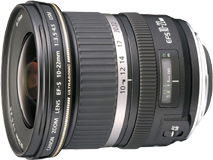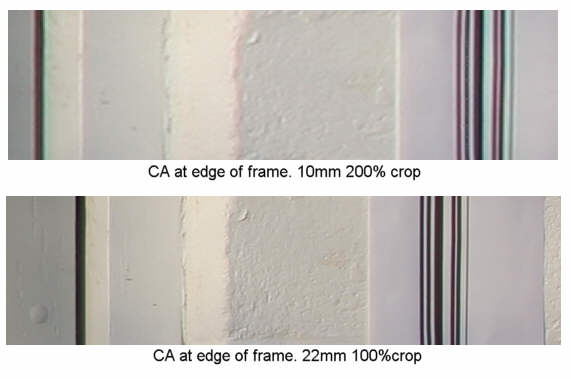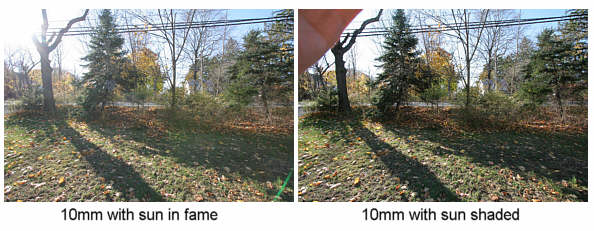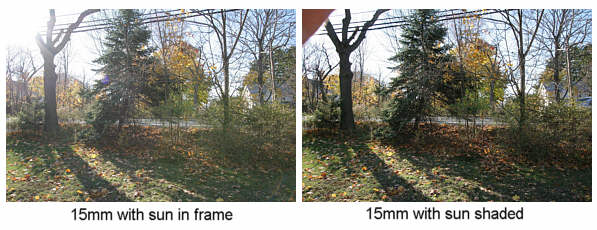
CANON EF-S 10-22/3.5-4.5 LENS REVIEW |
Canon EF-S 10-22/3.5-4.5 USM Lens Review
Chromatic AberrationChromatic aberration comes from a difference in magnification for different colors. It manifests itself as different colored fringes on either side of objects near the edge of the frame and is especially visible on subjects like dark tree branches against a bright sky or on any high contrast feature. The further away from the center of the frame, the greater the extent of CA, so it shows up most at the edges and corners of the frame. CA can be minimized by the use of special types of glass. The EF-S 10-22/3.5-4.5 has one Super UD element for this purpose. Super UD glass has ultra-low dispersion similar to that provided by exotic (and expensive) fluorite elements. [Dispersion is a property of glass that results in different optical properties for different colors of light].
At the 22mm setting I couldn't find any chromatic aberration. I set up the test target above with black and white stripes and placed it at the very right edge of the frame. The lower image above is a 100% crop from the edge of that image. There really isn't any CA visible at all. Excellent performance. The upper image shows a crop at 200% from the edge of the frame shot at 10mm. A small amount of CA is visisble in this shot. By the standards of superwide lenses, CA is very low, but it isn't zero. A number of programs can correct for chromatic aberration, or at least minimize it. Picture Window Pro can correct for CA in JPEGs or TIFF files. Photoshop can correct RAW images during the RAW conversion process. DxO corrects for CA if the appropriate lens module is available and Panorama Tools (freeware) can do CA correction, though the interface isn't very user friendly. FlareFlare is well controlled but you can see from the images below that with the sun in the frame there is some loss of contrast due to overall veiling flare. A green "streak" is also present in the lower right corner of the frame. Such intense "ghosts" are very dependant on the position of the flare source (sun) and the zoom position. With the direct sun shaded as seen on the right, contrast is restored and ghosting eliminated. Having the sun in the frame is a VERY severe test of course.
A lens hood helps when the sun is just outside the frame of course, though zoom hoods are much more efficient with the zoom at the wide end than the telephoto end of the range. A hood helps, but extra shading from a hand (preferably outside the frame!) can be as effective - and sometimes more effective. Similar results are found at other focal lengths as shown below for the lens set to 15mm.
MacroThis isn't really a macro lens, but it will give you about 0.17x ( slightly more than 1/6 life size) when close focused at the 22mm setting. That means you can image an area approximately 3.5" x 5.2" Distortion is low as can be seen from the image below which was shot at 22mm and at the closest focusing distance You can add a 500D close-up diopter, but there's little point. Maximum magnification goes from 0.17x to a whopping 0.20x. An EF 12 II extension tube is the best bet if you want more magnification. It will give you 0.77x, which is a useful increase. An EF 25 II is too much and will require the lens to be right up to the subject, giving you no working distance. CommentsI know people will ask "Why didn't you test this lens against the EF 17-40/4L?". Two reasons. First and most importantly, I don't have access to an EF 17-40/4L, so I can't! The second is that really, these should not be looked on as competing lenses. If you have a 1.6x DSLR (and if you don't, you won't be even considering the EF-S 10-22), then the 17-40/4L isn't really much of a wideangle. At its widest coverage is similar to that of a 28mm lens on a full frame camera which is just the start of the "wideangle" region. A 17-40/4L on a 1.6x DSLR acts like a "wide-to normal" 27 - 64mm zoom on a full frame camera.. On the other hand the EF-S 10-22/3.5-4.5 is a true superwide zoom. It's equivalent to the widest Canon zoom you can get for a full frame EOS SLR, a 16-35. That's superwide to "almost normal". The two lenses have different ranges and different functions. I really don't see them as competing lenses. The competition for the 17-40/4L on a 1.6x DSLR is probably the EF-S 17-85/3.5-5.6 IS, not the EF-S 10-22/3.5-4.5! Now a on an Canon EOS 5D vs. a on an EOS 20D would be an interesting comparison - but I don't have a 5D either! I also don't have any of the 3rd party superwide zooms on hand. Some time ago I did test the Tamron 11-18/4.5-5.6 and I found it to be a pretty good lens. However it's slower than the EF-S 10-22/3.5-4.5, it doesn't have USM and the zoom range is significantly less. It also showed a little higher levels of chromatic aberration. However it's $140 cheaper. Some people refuse to buy EF-S or other APS-C coverage lenses because "one day" they intend to own a full frame DSLR and I guess that's a valid viewpoint. It would be more valid if they actually owned a full frame DLSR now, but I suppose they are planning ahead. Personally I think I'll be shooting with a 1.6x DSLR for at least the next 3-4 years, and even if I buy a full frame DLSR at that point I'll probably keep a 1.6x body for backup. If I decide I don't want an EF-S lens at that point I'm sure I'll be able to sell it for at least 75% of what I paid for it, so even if it costs me $200 to own the lens for 4 years, I'm OK with that. It's about $1 per week. ConclusionsOverall the Canon EF-S 10-22/3.5-4.5 USM is a very good lens. It's well built, handles well, it's fast focusing, silent and sharp (even wide open), and chromatic aberration is generally well controlled. It covers a wider range than any of the 3rd party competitors. It's only downside is that it's more expensive. Note that all the 3rd party competitors (except for the Sigma 12-24) are also designed for APS-C format coverage, so though you can physically mount them on a full frame EOS body, they will either vignette badly or show low edge quality, so you probably wouldn't want to. It would be nice if you could mount the Canon lens on any EOS body, but you can't. I don't think it's a big loss, but it is a loss. So my final conclusion is that while you can get a cheaper lens, you can't really get a better superwide zoom for Canon 1.6x DSLRs then the EF-S 10-22/3.5-4.5 USM and you certainly can't get one that covers the whole 10-22mm range. If you can afford it (it's currently around $710), go for it. I bought one myself, so I'm not just saying that! Check out the current price at ADORAMA via the link below"
© Copyright Bob Atkins All Rights Reserved |
|



